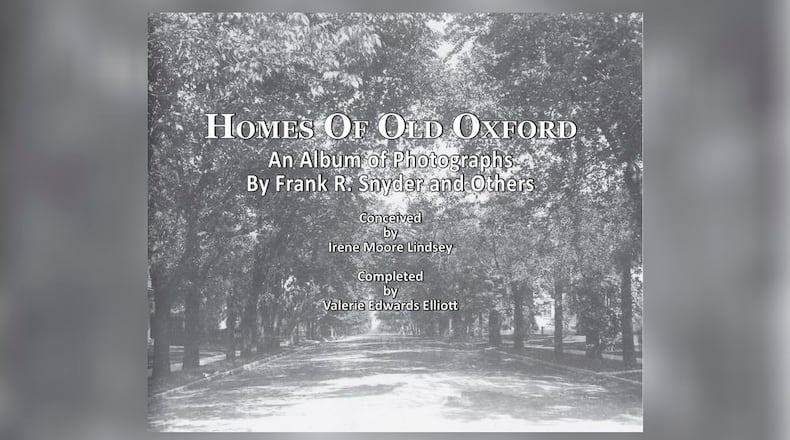“The new coffee table book is filled with black and white photographs of early 20th-century Oxford houses and captioned with brief histories and architectural descriptions,” Elliott said. “It should be of interest to historic preservationists, local history enthusiasts and anyone who has ever walked Oxford’s Mile Square.”
The book is entitled “Homes of Old Oxford: An Album of Photographs by Frank R. Snyder and Others” and the cover lists authorship as Conceived by Irene Moore Lindsey, Completed by Valerie Edwards Elliott.
In her introduction to the book, Elliott credits the late Irene Moore Lindsey, a longtime resident of Oxford and a person devoted to her community. She was the first woman elected to serve on the village council, as well as its planning commission and an active member of numerous community service organizations.
“She helped raise money to meet the challenge grant offered by the family of W.E. and Ophia D. Smith to create the Smith Library of Regional History that opened in 1981 as a division of Lane Public Libraries,” Elliott wrote in that introduction, noting Lindsey volunteered there and was made acting director when the director abruptly left the position. “It was due to her influence that the Library acquired a collection of beautiful black and white pictures taken by local photographer Frank R. Snyder (1875-1958). Drawing on her prior experience as Executive Editor of “House Beautiful” magazine, Irene conceived the idea of showcasing the Synder house photographs in a commemorative coffee table book and began work on the text after she retired.”
She was unable to complete the work but Elliott took on the task after her own retirement. Included are some house photographs by other local photographers, but Snyder’s work constitutes the majority of those in the book.
Each of the 75 houses is on its own page in the book with text describing its location, architecture and brief historical information about the inhabitants or, in many cases, the most prominent owner of the house.
In the back of the book are two listings of the houses – one by addresses so users can easily find a specific one they may be curious about and another alphabetical listing by name of the people who had lived there. A map in front locates each house by the number assigned to it in the book.
Some of the homes no long exist, having been torn down, and some now look quite different from the old photos because of renovations and additions. Locations range all over the map of Oxford but many can be found in a walk of several blocks. A walk around the blocks bounded by West Church, Elm and Spring streets and Campus Avenue would take people past more than half of the 75 locations. A couple go out College Corner Pike and a few are found on the Western Campus.
House number 1 may be the oldest in the book and is still standing at the corner of Spring Street and Campus Avenue. It is believed to have been built four decades before the Civil War. The home has been used as woolen mill and a creamery by different owners over the years.
House number 6 is Scott Manor, at 2 S. Campus Ave. The house no longer exists, replaced by Phi Delta Theta headquarters. The house, however, had been built in 1831 for the family of Miami University professor John Scott. His daughter, Caroline, was born in the house and grew up to become Caroline Scott Harrison, the First Lady of the United States.
The Richey House at 220 E. High St. was known for more than a century by another name, the “Lottie Moon House,” It was the home of the Sutton Richey family for 110 years, but the more common name attached to the house was due to the exploits of Charlotte Moon Clark, who served the Confederacy as a spy during the Civil War. Her family lived in the home for less than a decade in the 1840s and 1850s.
A one-page Frank R. Snyder biography is also part of the book. Snyder was helping his father with his photography business in Indiana and moved to Oxford in 1895. Two years later he opened a photography studio of his own which was later expanded into a store selling stationery, art supplies, cameras and gifts. The store was in business for 109 years.
He was the town’s leading photographer and a businessman involved in civic affairs and his house pictures were often taken soon after construction or a major renovation.
All surviving Snyder photos are accessible at the Miami University Archives and much of them at the Smith History Library.
The biography closes with the comment, “Those who treasure Oxford’s distinctive past are much in debt to Frank R. Snyder and his legacy.”
In her introduction, Elliott credits volunteer Elizabeth Johnson for augmenting Lindsey’s efforts, the W.E. Smith Family Charitable Trust for funding the publishing costs of the book, Curtis Ellison for editorial advice, Stephen Gordon for architectural descriptions, Sam Ashworth for the map design, Smith Library staff for additional assistance and Jacqueline Johnson of the Miami archives for tracking down some elusive information.
Copies are available for $10 at the Smith History Library on the second floor of the Oxford Lane Public Library.
About the Author
